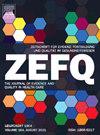癌症相关疲劳:德国癌症护理机构的护理质量如何(好)?]
IF 1.7
Q4 HEALTH POLICY & SERVICES
Zeitschrift fur Evidenz Fortbildung und Qualitaet im Gesundheitswesen
Pub Date : 2025-03-08
DOI:10.1016/j.zefq.2025.02.003
引用次数: 0
摘要
背景:癌症和/或其治疗最常见的后遗症之一是癌症相关性疲劳(CRF)。对于那些受影响的人来说,慢性肾功能衰竭往往伴随着相当大的,甚至是长期的损害。这使得检查在德国如何提供护理以及指南建议在临床实践中的实施程度变得更加重要。方法:在德国范围内的问卷调查中,要求住院和门诊肿瘤护理机构描述他们的CRF方法(信息和教育,筛查,诊断),当地治疗方案和临床试验。结果:共有145家机构参与,包括11家综合性癌症中心、35家器官特异性癌症中心、22家设有(血液)肿瘤科室的医院、29家门诊(血液)肿瘤诊所、48家门诊癌症咨询单位。几乎所有机构都报告向患者提供口头健康信息(每组:90.9%、88.6%、90.9%、96.9%、72.9%);书面表达频率较低(90.9%、54.3%、59.1%、48.3%、87.5%)。在多达三分之一的设施中对CRF进行了系统筛查(每组:27.3%,20.0%,31.8%,17.2%,8.3%)。少数机构有进一步澄清CRF的标准化程序(0%、11.4%、13.6%、6.9%、2.1%)。运动(90.9%,82.9%,72.7%,79.3%,89.6%)和心理治疗服务(90.9%,68.6%,86.4%,62.1%,68.8%)在各机构组中最常被积极推荐给CRF患者。讨论:关于CRF筛查和诊断的系统化以及信息材料的提供,指南建议与日常临床实践之间存在明显差异。本文章由计算机程序翻译,如有差异,请以英文原文为准。
Fatigue bei Krebs: Wie (gut) sind Betroffene an onkologischen Einrichtungen in Deutschland versorgt?
Background
One of the most common sequelae of cancer and/or its treatment is cancer-related fatigue (CRF). For those affected, CRF is often accompanied by considerable, even long-term impairment. This makes it all the more important to examine how care is provided in Germany and to what extent guideline recommendations are implemented in clinical practice.
Methods
In a Germany-wide questionnaire survey, inpatient and outpatient oncological cancer care facilities were asked to describe their approach to CRF (information and education, screening, diagnostics), local treatment options, and clinical trials.
Results
A total of 145 facilities participated, including 11 comprehensive cancer centers, 35 organ-specific cancer centers, 22 hospitals with a (hemato-)oncology unit, 29 outpatient (hemato-)oncology practices, 48 outpatient cancer counseling units. Nearly all the facilities reported that patients are provided verbal health information (per groups: 90.9%, 88.6%, 90.9%, 96.9%, 72.9%); less frequently in written form (90.9%, 54.3%, 59.1%, 48.3%, 87.5%). A systematic screening for CRF is conducted in up to one-third of the facilities (per groups: 27.3%, 20.0%, 31.8%, 17.2%, 8.3%). A standardized procedure for further clarification of CRF is available at a small number of institutions (0%, 11.4%, 13.6%, 6.9%, 2.1%). Exercise (90.9%, 82.9%, 72.7%, 79.3%, 89.6%) and psychotherapeutic services (90.9%, 68.6%, 86.4%, 62.1%, 68.8%) are most frequently actively recommended to patients with CRF across the facility groups.
Discussion
With regard to the systematization of screening and diagnosis of CRF as well as the provision of information material, there is a clear discrepancy between guideline recommendations and everyday clinical practice.
求助全文
通过发布文献求助,成功后即可免费获取论文全文。
去求助
来源期刊

Zeitschrift fur Evidenz Fortbildung und Qualitaet im Gesundheitswesen
HEALTH POLICY & SERVICES-
CiteScore
1.90
自引率
18.20%
发文量
129
 求助内容:
求助内容: 应助结果提醒方式:
应助结果提醒方式:


